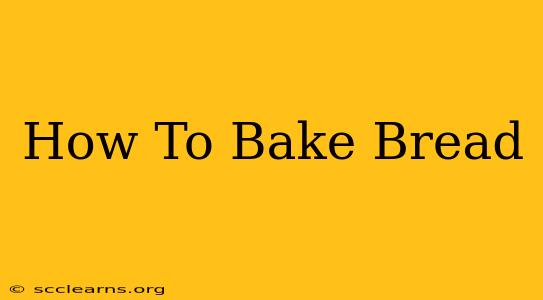Baking bread might seem intimidating, but with a little patience and the right technique, you can create delicious, crusty loaves right in your own kitchen. This comprehensive guide will walk you through the process, from choosing the right ingredients to achieving that perfect golden-brown crust.
Understanding the Ingredients: The Foundation of Great Bread
Before you even start mixing, it's crucial to understand the role each ingredient plays. The quality of your ingredients directly impacts the final product.
Flour: The Heart of the Matter
- Bread flour: This flour has a higher protein content than all-purpose flour, resulting in a stronger gluten structure, crucial for chewy bread. It's the ideal choice for most loaves.
- All-purpose flour: While usable, it may produce a slightly less chewy loaf. It works well for simpler recipes.
- Whole wheat flour: Adds a nutty flavor and increased fiber, but can result in a denser loaf. Consider blending it with bread flour for best results.
Yeast: The Rising Star
- Active dry yeast: The most common type, requiring activation in warm water before use. Follow package instructions carefully.
- Instant yeast: Can be added directly to the dry ingredients, eliminating the activation step. Again, check package directions.
Water: More Than Just a Liquid
The temperature of your water is crucial. Too cold, and the yeast won't activate properly. Too hot, and you'll kill the yeast. Aim for lukewarm (around 105-115°F).
Salt: Flavor and Structure
Salt enhances the flavor of the bread and controls the yeast activity, preventing overly rapid fermentation.
Sugar (Optional): Fuel for the Yeast
A small amount of sugar provides food for the yeast, promoting faster rising. Many recipes omit it successfully.
The Baking Process: Step-by-Step Instructions
This guide uses a basic no-knead method, perfect for beginners.
Step 1: Mixing the Dough
In a large bowl, combine the flour, yeast, and salt. Gradually add the lukewarm water, mixing with a wooden spoon or your hands until a shaggy dough forms.
Step 2: First Rise (Bulk Fermentation)
Cover the bowl and let the dough rise in a warm place for 1-1.5 hours, or until doubled in size. This is where the magic happens – the yeast is working its way through the dough, creating those beautiful air pockets.
Step 3: Shaping the Dough
Gently turn the dough out onto a lightly floured surface. Shape it into a round or oval loaf.
Step 4: Second Rise (Proofing)
Place the shaped dough in a well-floured banneton basket (or a bowl lined with a floured kitchen towel) seam-side up. Cover and let it rise for another 45-60 minutes, or until almost doubled.
Step 5: Baking the Bread
Preheat your oven to 450°F (232°C) with a Dutch oven inside. Carefully transfer the dough from the banneton into the hot Dutch oven. Cover and bake for 30 minutes.
Step 6: The Crusty Finish
Remove the lid and bake for another 15-20 minutes, or until the crust is deeply golden brown and the internal temperature reaches 200-210°F (93-99°C).
Step 7: Cooling and Enjoying
Remove the bread from the Dutch oven and let it cool completely on a wire rack before slicing and enjoying your freshly baked masterpiece!
Tips for Baking Success
- Use a kitchen scale: For consistent results, weigh your ingredients.
- Don't overwork the dough: Gentle handling is key.
- Be patient: Allow ample time for rising.
- Experiment with flavors: Add herbs, seeds, or nuts to customize your bread.
Beyond the Basics: Exploring Different Breads
Once you've mastered the basics, explore different types of bread, such as sourdough, rye, or focaccia. The world of bread baking is vast and endlessly rewarding! Happy baking!

